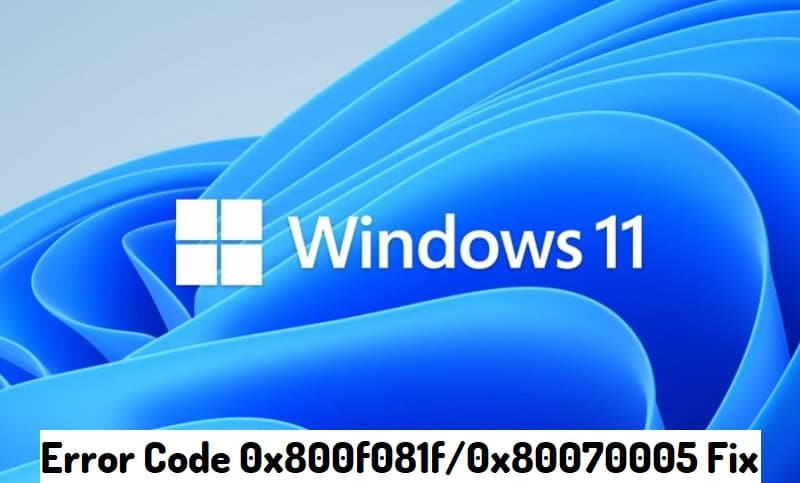If you’re excited about upgrading your system to the latest Windows 11 update but are encountering the frustrating Error Code 0x800f081f or 0x80070005, don’t worry! These errors are not uncommon, and there are effective solutions to get your installation back on track. In this guide, we’ll walk you through the steps to troubleshoot and fix these error codes so you can smoothly install the Windows 11 updates (KB5029263/KB5029253) without a hitch.
Before we head over, check out our other guides on several other Windows 11 updates not installing errors.
Installing updates is crucial for maintaining the security and performance of your operating system. However, encountering errors during installation can be frustrating. In this guide, we’ll address the Error Code 0x800f081f and 0x80070005, which can occur when installing Windows 11 updates KB5029263/KB5029253, and provide step-by-step solutions.
What is Error Code 0x800f081f and 0x80070005?
Error Code 0x800f081f often indicates a problem with the Windows Update components, while Error Code 0x80070005 points to permission issues. These errors can prevent the update from being installed successfully.
How to Fix Error Code 0x800f081f/0x80070005 When Installing Windows 11 Update KB5029263/KB5029253?
Below you can find 13 different ways to fix the error code 0x800f081f/0x80070005 when installing Windows 11 update KB5029263/KB5029253 on your PC.
1. Run the Windows Update Troubleshooter
- Press Windows + I to open the Settings menu.
- Navigate to “Update & Security” and select “Troubleshoot” from the sidebar.
- Click on “Additional troubleshooters” and run the “Windows Update” troubleshooter.
- Follow the on-screen instructions to complete the troubleshooting process.
If the troubleshooter detects and fixes any issues, attempt to install the updates again.
2. Use the DISM Tool
- Open Command Prompt as an administrator.
- Type the command DISM /Online /Cleanup-Image /RestoreHealth and press Enter.
- Wait for the process to complete.
- Once done, restart your computer.
3. Update Windows 11 Using Media Creation Tool
- Visit the official Microsoft website and download the “Windows 11 Media Creation Tool.” using the second option which is “Create Windows 11 Installation Media.”
- Download the tool and run it on a working computer.
- Accept the terms and conditions, and select the option to “Create installation media (USB flash drive, DVD, or ISO file) for another PC.”
- Choose the language, edition, and architecture (32-bit or 64-bit) that matches your system.
- Select either a USB flash drive or ISO file as the installation media.
- If using a USB flash drive, connect it to the computer, and select the appropriate drive.
- Wait for the Media Creation Tool to download the necessary files and create the bootable media.
- Once the process is complete, restart the computer and boot from the USB drive or DVD.
- Follow the on-screen instructions to install a fresh copy of Windows 11.
- During the installation, you may be prompted to enter your product key. Ensure you have it handy.
- Follow the remaining steps to complete the installation.
- After the installation is finished, reinstall your necessary applications and restore your backed-up files.
4. Perform a Clean Boot
- Press Windows + R, type msconfig, and press Enter.
- In the System Configuration window, go to the Services tab.
- Check Hide all Microsoft services and click Disable all.
- Go to the Startup tab and click Open Task Manager.
- Disable all startup items from the Task Manager.
- Close the Task Manager and click OK in the System Configuration window.
- Restart your computer and attempt to install the updates.
5. Manually Download and Install the Update
- Visit the Microsoft Update Catalog website.
- Search for the KB5029263/KB5029253 update.
- Download the appropriate version for your system.
- Double-click the downloaded file to install the update.
6. Check Disk Space
- Press Windows + E to open File Explorer.
- Right-click on the drive where Windows is installed and select “Properties.”
- Ensure there is enough free space (at least 20GB) for the update to install.
7. Check Disk for Errors
Disk errors can sometimes prevent updates from installing correctly. Here’s how to check and fix disk errors:
- Press Windows + S, type Command Prompt, right-click it, and select Run as administrator.
- In the Command Prompt, type chkdsk /f and press Enter.
- You might need to restart your computer. Confirm by typing Y and pressing Enter.
- After the disk check and repairs are complete, try installing the updates again.
8. Disable Third-Party Security Software
- Locate the third-party antivirus or security software icon in the system tray.
- Right-click on the icon and choose “Disable” or “Turn Off.”
- Confirm the action and attempt the update installation.
9. Reset Windows Update Components
Method 1
This method will automatically stop and restart all the Windows update services on your Windows 11 PC.
- Open Notepad on your PC.
- Now, copy and paste all the commands given below to the Notepad and save it on your desktop with the file name Wufix.bat.
- SC config trustedinstaller start=auto
- net stop bits
- net stop wuauserv
- net stop msiserver
- net stop cryptsvc
- net stop appidsvc
- Ren %Systemroot%\SoftwareDistribution SoftwareDistribution.old
- Ren %Systemroot%\System32\catroot2 catroot2.old
- regsvr32.exe /s atl.dll
- regsvr32.exe /s urlmon.dll
- regsvr32.exe /s mshtml.dll
- netsh winsock reset
- netsh winsock reset proxy
- rundll32.exe pnpclean.dll,RunDLL_PnpClean /DRIVERS /MAXCLEAN
- dism /Online /Cleanup-image /ScanHealth
- dism /Online /Cleanup-image /CheckHealth
- dism /Online /Cleanup-image /RestoreHealth
- dism /Online /Cleanup-image /StartComponentCleanup
- Sfc /ScanNow
- net start bits
- net start wuauserv
- net start msiserver
- net start cryptsvc
- net start appidsvc
- Right-click on the Wufix file and click Run as administrator.
- Restart your PC.
- After the PC restarts, try installing or updating your Windows 11 again, and the error shouldn’t be there.
Method 2
- Open the Command Prompt as an administrator.
- Type the following commands one by one, pressing Enter after each:
- net stop wuauserv
- net stop cryptSvc
- net stop bits
- net stop msiserver
- Next, type ren C:\Windows\SoftwareDistribution SoftwareDistribution.old and press Enter.
- Then, type ren C:\Windows\System32\catroot2 catroot2.old and press Enter.
- Finally, restart the services by typing the following commands:
- net start wuauserv
- net start cryptSvc
- net start bits
- net start msiserver
- Close the Command Prompt and attempt to install the update again.
10. System Restore
If none of the above methods work and you recently made changes to your system, you can try a system restore:
- Press Windows + S, type Create a restore point, and open the corresponding setting.
- Click System Restore and follow the prompts to restore your system to a point before the problematic update.
11. Modify Group Policy Settings
- Press Windows + R, type gpedit.msc, and press Enter.
- Navigate to “Computer Configuration” > “Administrative Templates” > “System.”
- Find and double-click on “Specify settings for optional component installation and component repair.”
- Select “Enabled” and set the option to “Never attempt to download payload from Windows Update.”
- Click “OK” and restart your computer.
12. Check System Files
- Open Command Prompt as an administrator.
- Type the command sfc /scannow and press Enter.
- Wait for the scan to complete and follow any repair instructions provided.
13. Seek Professional Assistance
If none of the methods work, consider seeking help from Microsoft support or a professional technician.
Conclusion
Encountering Error Code 0x800f081f or 0x80070005 when installing Windows 11 updates can be frustrating, but with the right steps, you can overcome these obstacles. By following the troubleshooting methods outlined in this guide, you can ensure a smooth update process and enjoy the latest features and security enhancements that Windows 11 offers.
Frequently Asked Questions (FAQs)
Q1: Can I skip troubleshooting and wait for the next update?
A: It’s not recommended. Skipping updates can leave your system vulnerable to security risks. It’s best to resolve the issue promptly.
Q2: Will performing a clean boot affect my data?
A: No, a clean boot only temporarily disables startup programs. Your data will remain intact.
Q3: How do I know if my system files are corrupted?
A: You can use the SFC tool to scan and repair corrupted files. The tool will notify you if any issues are found.
Q4: Can third-party antivirus software be the sole cause of the error?
A: While possible, other factors can contribute to the error. It’s recommended to disable security software temporarily for troubleshooting.
Q5: What if I’m uncomfortable performing these steps on my own?
A: If you’re not confident in your technical skills, consider seeking help from Microsoft support or a professional computer technician.








